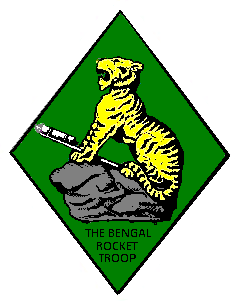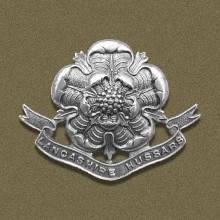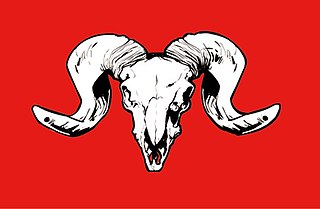
The Royal Regiment of Artillery, commonly referred to as the Royal Artillery (RA) and colloquially known as "The Gunners", is one of two regiments that make up the artillery arm of the British Army. The Royal Regiment of Artillery comprises thirteen Regular Army regiments, the King's Troop Royal Horse Artillery and five Army Reserve regiments.

The 105th Medium Battery is a unit of the Royal Regiment of Australian Artillery that can trace its history back to March 1916, when it was raised as 105th Howitzer Battery in Egypt. The battery is based at Gallipoli Barracks, Enoggera, Queensland, as a full-time regular army unit and is one of three batteries that make up the 1st Regiment, in the 7th Brigade.
39 Regiment Royal Artillery (RA) was part of the British Army's Royal Artillery. Its name is pronounced "three nine", The Regiment was one of the Depth fire units of 1st Artillery Brigade, part of the British Army. It was formed in 1947, and placed into suspended animation on 20 February 2015. The Regiment was based at Albemarle Barracks in Northumberland.
26th Regiment Royal Artillery is a regiment of the Royal Artillery in the British Army. The regiment is equipped with MLRS and is 3rd Division's divisional fires regiment.
3rd Regiment Royal Horse Artillery is a regiment of the Royal Horse Artillery in the British Army. They are currently based at Albemarle Barracks, Northumberland, England.
1st Regiment Royal Horse Artillery is a regiment of the Royal Horse Artillery in the British Army. It currently serves in the armoured field artillery role, and is equipped with the AS90 self-propelled gun. The regiment is currently based at Larkhill Garrison, Larkhill. The regiment completed its move from Assaye Barracks, Tidworth, to Larkhill in June 2019.

5th Regiment Royal Artillery is a regiment of the Royal Artillery in the British Army. It was formed in 1939 as 5th Regiment Royal Horse Artillery before being redesignated in 1958. It currently serves in the Surveillance and Target Acquisition role and is equipped with radars and acoustic sound ranging equipment; it also provides Special Observation Post teams.
7th Parachute Regiment, Royal Horse Artillery is a regiment of the Royal Artillery in the British Army. It currently serves in the field artillery role with 16 Air Assault Brigade Combat Team, and is equipped with the L118 Light Gun.

176 Battery Royal Artillery is the junior currently-existent regular battery of the Royal Artillery. Its name is pronounced "One Seven Six", and the battery is commonly referred to as "The Abus", and its members as "Abus", after the battery's Honour Title. The battery is one of the sub-units of 26th Regiment Royal Artillery, part of the British Army. It was formed in 1860 and since then has participated in many campaigns, most notably the Battle of Abu Klea in 1885, where Gunner Smith earned a Victoria Cross and later its Honour Title.

132 Battery Royal Artillery is an MLRS Battery, that is part of the Royal Artillery. Its name is pronounced "one three two" or it is known as "The Bengals". The battery is one of the sub-units of 26th Regiment Royal Artillery, part of the British Army. It was formed in 1816 and is based in Larkhill.

The Lancashire Hussars was a British Army unit originally formed in 1798. It saw action in the Second Boer War, the First World War and the Second World War. In 1969, the regiment reduced to a cadre and the Yeomanry lineage discontinued.

The South Nottinghamshire Hussars is a unit of the British Army formed as volunteer cavalry in 1794. Converted to artillery in 1922, it presently forms part of 103 Regiment, Royal Artillery.
205 Battery Royal Artillery is part of the 101st (Northumbrian) Regiment Royal Artillery and is equipped with the M270 Multiple Launch Rocket System. It is based in South Shields, United Kingdom.
1st Anti-Aircraft Brigade was an Air Defence formation of the British Army, during the Second World War, and served in the Battle of France and during The Blitz. It then transferred to the Middle East, where it defended the Eighth Army's lines of communication during the final phases of the North African Campaign.

The 1st Artillery Brigade was a support formation of the British Army from 1961-77 and from 1997. Part of the 3rd Division, it oversaw all army close support artillery and deep fires units. Under the Future Soldier programme, the brigade merged with 1st Armoured Infantry Brigade to form 1st Deep Reconnaissance Strike Brigade Combat Team.
The London Heavy Brigade, Royal Garrison Artillery was a unit of the British Territorial Force formed in 1908. It fought on the Western Front during World War I, and its successors served in the Mediterranean and North-West Europe theatres during World War II.
T Battery Royal Artillery is an air defence battery of the Royal Artillery that serves with the British Army's 12 Regiment Royal Artillery. It is stationed at Baker Barracks, Thorney Island, West Sussex.
The following is a hierarchical outline for the structure of the British Army in 1989. The most authoritative source for this type of information available is Ministry of Defence, Master Order of Battle, and United Kingdom Land Forces, HQ UKLF, UKLF ORBAT Review Action Plan, HQ UKLF, 1990.
50 Missile Regiment Royal Artillery was an artillery regiment of the British Army. From the late 1950s it was stationed with the British Army of the Rhine in Germany, at Northumberland Barracks, Menden, equipped with 8-inch towed howitzers, the Honest John, and, from 1976, the MGM-52 Lance surface to surface missile.

The 3rd (Ulster) Searchlight Regiment was a Supplementary Reserve (SR) unit of the Royal Artillery raised in Northern Ireland just before the outbreak of World War II. It distinguished itself in the Battle of France before being evacuated from Dunkirk. It then served in Anti-Aircraft Command, converting into the 4th (Ulster) Light Anti-Aircraft Regiment in 1942. In that role it served in the campaign in North West Europe, defending Brussels against V-1 flying bombs. It was reformed postwar and its successor units continued to serve in the Territorial Army (TA) until 1993.








